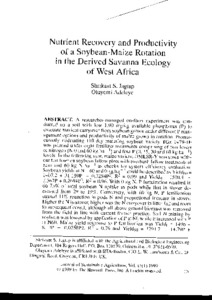| dc.contributor.author | Jagtap, S.S. |
| dc.contributor.author | Adeleye, O. |
| dc.date.accessioned | 2019-12-04T11:26:40Z |
| dc.date.available | 2019-12-04T11:26:40Z |
| dc.date.issued | 1999 |
| dc.identifier.citation | Jagtap, S.S. & Adeleye, O. (1999). Nutrient recovery and productivity of a soybean-maize rotation in the derived savanna ecology of West Africa. Journal of Sustainable Agriculture, 15(1), 75-85. |
| dc.identifier.issn | 1044-0046 |
| dc.identifier.uri | https://hdl.handle.net/20.500.12478/4700 |
| dc.description.abstract | A researcher-managed on-farm experiment was conducted on a soil with low 1.90 mg/kg available phosphorus (P) to evaluate nutrient carryover from soybean grown under different P management options and productivity of maize grown in rotation. Promiscuously nodulating 110-day maturing soybean variety TGx 1479-1E was planted under eight fertilizer treatments comprising of two levels of nitrogen (N 0 and 60 kg ha−1) and four P (0,15, 30 and 60 kg ha−1) levels. In the following year, maize variety, DMLSR-Y was sown without fertilizer on soybean fallow plots with two bush fallow treatments at zero and 60 kg N ha−1 as checks for system efficiency evaluation. Soybean yields at N = 60 and 0 kg ha−1 could be described as Yield60 = 1407.2 + 31.159P − 0.3284P2, R2 = 0.99 and Yield0 = 1590.4 − 7.367P + 0.2694P2, R2 = 0.96. With 0 kg N, P fertilization resulted in 66–75% of total soybean N uptake in pods while that in stover decreased from 29 to 19%. Conversely, with 60 kg N, P fertilization caused 11% reduction in pods N and proportional increase in stover. Higher the N in stover, higher was the N carryover in litter fall and roots to subsequent cereal, although all above ground biomass was removed from the field in line with current farmer practice. Soil N mining by soybean was lowered by application of P at N0 while it increased with P at N60. Maize yield response to P fertilization was Yield0 = 1496 + 8.14P − 0.0758P2, R2 = 0.76 and Yield60 = 1791.7 − 14.79P + 0.1727P2, R2 = 0.93. Maize following soybean yielded 4–28% higher than the yield from bush fallow but 19–32% lower than the maize supplied with 60 kg N ha−1. Of the N estimated to have been retained in the field only 10% was recovered in the maize and remaining was lost to leaching, carried away by wind and animal grazing. Soil N monitored during non-cropped and cropped periods showed greater nutrient concentrations in the soybean fallow plots than in the bush fallow plots, which declined rapidly with increasing rainfall. Overall results shows that maize following soybean was productive, soil nutrient conserving and nutrient efficient than the maize grown on the bush fallow plots. Economic analysis of the two production systems showed that gross returns from soybean-maize rotation were $275–617 higher than the maize-maize rotation with no N inputs at all levels of P. The gross returns were comparable to the maize-maize rotation with 60-kg N ha-1 from soybean fallow plots with 60 kg N and at least 30-kg P ha-1. Farmer adoption and profitability may be further enhanced with strategies that improve nutrient recovery in subsequent maize and retain maximum stover as litter fall in the field. |
| dc.language.iso | en |
| dc.subject | Crop Rotation |
| dc.subject | Economic Analysis |
| dc.subject | Maize |
| dc.subject | Soybeans |
| dc.title | Nutrient recovery and productivity of a soybeanmaize rotation in the derived savanna ecology of West Africa |
| dc.type | Journal Article |
| dc.description.version | Peer Review |
| cg.contributor.affiliation | University of Florida |
| cg.contributor.affiliation | International Institute of Tropical Agriculture |
| cg.coverage.region | Africa |
| cg.coverage.region | West Africa |
| cg.iitasubject | Farming Systems |
| cg.iitasubject | Maize |
| cg.iitasubject | Soybean |
| cg.accessibilitystatus | Limited Access |
| local.dspaceid | 101523 |
| cg.identifier.doi | https://doi.org/10.1300/J064v15n01_07 |

